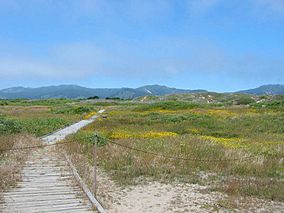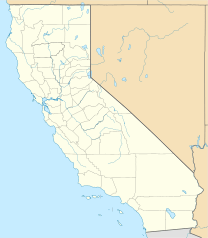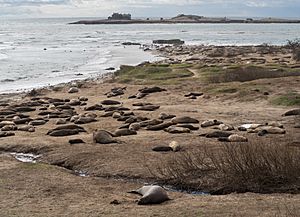Año Nuevo State Park facts for kids
Quick facts for kids Año Nuevo State Park |
|
|---|---|
|
IUCN Category III (Natural Monument)
|
|

Año Nuevo State Park
|
|
| Location | San Mateo County, California, USA |
| Nearest city | Pescadero, California |
| Area | 4,209 acres (17.03 km2) |
| Established | 1985 |
| Governing body | California Department of Parks and Recreation |
| Designated: | 1980 |
Año Nuevo State Park is a special park in California, USA. It includes Año Nuevo Island and a place called Año Nuevo Point. This area is famous for its large groups of pinnipeds, which are marine mammals like seals and sea lions.
The park is located in San Mateo County. It's a low, rocky, and windy point that sticks out into the Pacific Ocean. It's about 55 miles (88 km) south of San Francisco. In 2008, Año Nuevo State Natural Reserve became part of Año Nuevo State Park.
This park has many different kinds of plants. You can find very old trees, freshwater marshes, and forests with red alder and knobcone pine trees. Four streams flow through the park all year. These streams are home to steelhead and coho salmon. The park's wetlands also protect rare animals like the San Francisco garter snake and the California red-legged frog.
The park also has important historical sites. There are remains of an old Native American village. You can also see buildings from the 1800s at Cascade Ranch. The park helps protect important wildlife paths in the region. The point itself looks much like it did when explorer Sebastián Vizcaíno saw it from his ship in 1603.
Contents
Park History
Early People and Explorers
The Quiroste Ohlone were the first known people to live in the Año Nuevo area. After the Spanish founded Mission Santa Cruz in 1791, many Quiroste people died. This was due to diseases the Spanish brought with them.
A Spanish explorer named Sebastian Vizcaino sailed past the point on January 3, 1603. His chaplain, Father Antonio de la Ascensión, named it Punta de Año Nuevo. This means "New Year's Point" because they saw it on New Year's Day.
The first European land trip in Alta California was the Spanish Portolà expedition in 1769. The explorers recognized Point Año Nuevo. On their way back to San Diego, they camped at Año Nuevo Creek on November 19. A missionary named Juan Crespi wrote in his diary about seeing the point.
Changes Over Time
In the mid-1800s, things started to change. Año Nuevo Island was developed, and farming began in the area. Long ago, many elephant seals lived here. But hunters greatly reduced their numbers. Since the mid-1900s, the seal population has grown a lot. Today, you can see many elephant seals at the park.
In 2020, the Save the Redwoods League bought a piece of land called Cascade Creek. This land connects Año Nuevo State Park with Big Basin Redwoods State Park.
Amazing Animals of Año Nuevo
Año Nuevo State Park is a special place for marine mammals. Northern elephant seals, California sea lions, sea otters, and other animals come ashore here. They rest, find mates, and give birth on the sand dunes, beaches, and islands. Many thousands of people visit each year to see them.
The park has one of the biggest breeding places for northern elephant seals on the mainland. Another large colony is about 100 miles (160 km) south. During the winter breeding season, many people want to visit. It's a good idea to make reservations early. The male seals fight for mates on the beaches. The female seals give birth to their pups on the dunes.
From mid-December to late March, you can only visit the reserve on guided walks. Most adult seals leave by mid-March. But the young pups stay until April. Elephant seals return to the beaches in spring (females) and summer (males) to shed their skin. You can see them during this time with a special permit. You can call to make reservations for a guided walk.
Visitor Information
The park has a Visitor Center. It has exhibits about nature and a bookstore. You can buy books, postcards, and posters there. Restrooms, drinking water, and picnic tables are only available near the Visitor Center. The park does not sell food or drinks.
The parking lot is just west of California Route 1. The former Cascade Ranch area has steep hiking trails in the hills.
Nearby Attractions
Año Nuevo State Marine Conservation Area and Greyhound Rock State Marine Conservation Area are two protected ocean areas. They are located just off the coast of Año Nuevo State Park. Like underwater parks, these areas help protect ocean wildlife.
Other parks and beaches are close to Año Nuevo. These include Pigeon Point Light Station State Historic Park and Butano State Park.




